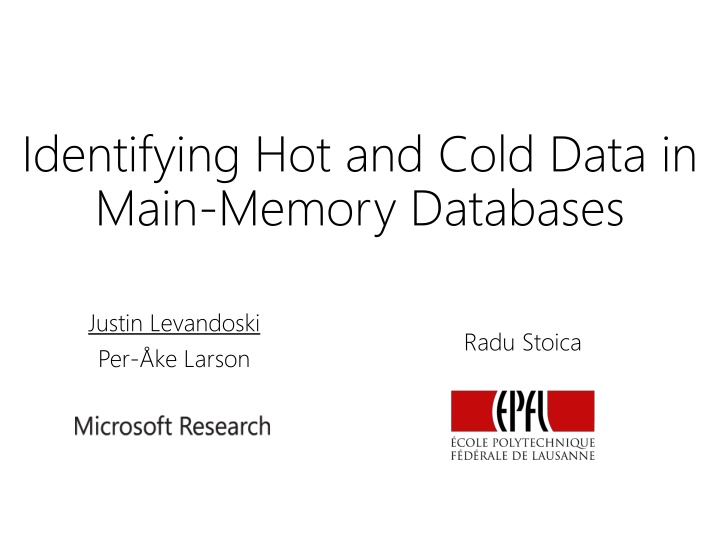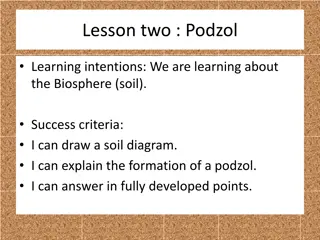
Managing Hot and Cold Data in Main-Memory Databases
Learn about identifying and managing hot and cold data in main-memory databases, including the importance of caching, minimizing space overhead, and performance optimization techniques.
Download Presentation

Please find below an Image/Link to download the presentation.
The content on the website is provided AS IS for your information and personal use only. It may not be sold, licensed, or shared on other websites without obtaining consent from the author. If you encounter any issues during the download, it is possible that the publisher has removed the file from their server.
You are allowed to download the files provided on this website for personal or commercial use, subject to the condition that they are used lawfully. All files are the property of their respective owners.
The content on the website is provided AS IS for your information and personal use only. It may not be sold, licensed, or shared on other websites without obtaining consent from the author.
E N D
Presentation Transcript
Identifying Hot and Cold Data in Main-Memory Databases Justin Levandoski Per- ke Larson Radu Stoica
Cold Data Records accessed infrequently in OLTP setting May have become irrelevant to workload Time-correlated and natural skew in real workloads UPS packages Some users more active than others
Cold Data (2) Do we need to keep cold data in memory? 200 RAM Price (1000s of $) 180 160 System 140 2TB Flash (high) 120 2TB Flash (low) 100 80 60 High-density DRAM comes at a large premium 40 20 0 16 64 128 256 512 1024 2048 1U 1U 2U 2U 4U 4U System Memory (GB) The N-Minute Rule for modern hardware prices Store on Flash After Record Size 200 Bytes 1 KB 2KB 4KB 60 Minutes 11.6 Minutes 5.8 Minutes 2.9 Minutes
Microsoft SQL Server Hekaton Main-memory optimized database engine targeting OLTP workloads Designed for high-levels of concurrency Multi-version optimistic concurrency control Latch-free data structures Record-centric data organization No page-based organization Oblivious to OS memory pages
Motivation First step in managing cold data is identifying it Why not caching? No page-based organization to exploit Only record granularity Space overhead Cache techniques requires per-item statistics Overhead on critical path Cache techniques require book-keeping on critical path Queue updates introduce 25% overhead in our system No need to meet a hard deadline Property we can exploit Cold data management is a performance/cost optimization
Requirements Minimize space overhead Cannot store access statistics on records in the database 8 Bytes * 50B records = 372 GB Minimize overhead on critical path Main-memory systems have short critical paths (speed) Remove hot/cold classification decision from critical path
Outline Overview of approach Siberia Logging and Sampling Exponential smoothing Classification Algorithms Performance Conclusion
Siberia: Cold Data Management Project studying cold data management in Hekaton 1. Cold data classification (this talk) 3. Cold data access and migration Index Cursor Offline analysis Access log Cold record cache Scanner 4. Cold storage access reduction Hot index scanner Cold index scanner Access filters Update memo Memory (hot storage) 2. Storage techniques Siberia (cold storage) Periodic migration
Logging and Sampling <t1> RID2 RID6 RID3 <t2> RID1 RID4 RID2 <t3> RID1 RID5 Log record accesses Accesses can be batched and written asynchronously Write only a sample of record accesses to the log Sampling minimizes overhead on the critical path Analyze log to classify hot and cold records Can be done periodically Classification can be moved to separate machine if necessary
Exponential Smoothing Used to estimate access frequencies ? ?? = ? ???+ ? ? ?(?? ?) W(tk): Score at time tk Xtk: observed value at time tk : decay constant In our scenario, xtk = 1 if observed, 0 otherwise Example timeline for single record: 1 0 0 0 1 1 tB=t1 t2 tn=tE t3 . . . .
Exponential Smoothing (2) Chosen due to simplicity and high accuracy Advantages over well-known caching policies Works very well with sampling SES LRU-2 ARC 9 Lower is better 8 Loss in Hit Rate (%) 7 6 5 4 3 2 1 0 0.01 0.02 0.05 0.10 0.20 0.40 0.80 1.60 3.10 6.30 12.5025.0050.00 Hot Data Size (% of Total Data) Vs. Well-known Caching Techniques
Outline Overview of approach Classification Algorithms Forward approach Backward approach Performance Conclusion
Classification Algorithms All of our classification algorithms take the same input and produce the same output Input Log of sampled record accesses Parameter K, signifying number of hot records Output K hot record Ids All approaches use exponential smoothing 13
Forward Algorithm Record ID Estimate Last Access t1 A .45 t4 t2 t7 t3 t8 G .98 L .03 P .34 Z .20 tn Forward algorithm Scan log forward from time t1 to tn Upon encountering an access for a record, update its estimate in a hash table Update estimate as: ? ?? = ? ???+ ?(?????)(? ?)?? ???? ?????? Once scan is finished, classify top K records with highest access frequency estimate as hot (the rest as cold) 14
Forward Algorithm in Parallel Hash partition by record id Assign a worker thread per partition Final classification done using estimates from every partition Partition the log by time Assign a worker thread to each log segment Each thread calculates partial estimate for its segment Segment2 Segment1 Segment3 t1 tn tb ta Thread1 Thread2 Thread3 15
Backward Algorithm Avoid scanning entire log from beginning to end Algorithm Scan log backward from time tn to t1 t1 Sharpen upper and lower bound for record s final estimate tn Ocassionally attempt classification using estimate bounds Discard records that cannot possibly be in hot set Time slice tn-4: Time slice tn: Kth lower bound Kth lower bound thrown out below threshold, disregard
Calculating Bounds Assume record will be present in every time slice moving back in the log UpperR(tk) wR(tk) LowerR(tk) Assume record will not be observed again in the log For record R at time tk, calculate base estimate as: ?? ??+ ??(?????) ???? = ? 1 ? tlast is timeslice of last observed record access, where tlast > tk Upper bound on final estimate value ???????? = ???? + (1 ?)?? ??+1 Lower bound on final estimate value ???????? = ???? + (1 ?)?? ??+1
Backward Algorithm in Parallel Partition log into N pieces using hash function on record id Log Hash Function . Log1 Log2 LogN
Phase I: Initialization Coordinator Thread K=9 Thread1 Thread2 Thread3 Log1 Log2 LogN N worker thread and one coordinator thread Each worker reads back in log segment to find all records in contention for local top K/N Each worker may read back different lengths
Phase I: Initialization (2) Global Statistics Threshold Upper Lower .6 - .8 21 9 Coordinator Thread Thresh: 0.7 Upper: 6 Lower: 3 Thresh: 0.8 Upper: 8 Lower: 3 Thresh: 0.6 Upper: 7 Lower: 3 Thread1 Thread2 Thread3 0.8 0.7 0.6 Each worker thread reports only three values: Its local K/Nth threshold value Upper bound: number of records that are in contention to be in top K/N records Lower bound: minimum number of records that can be in top K/N records
Phase II: Threshold Search Final global threshold that renders at least K records is between high and low thresholds initialization phase Controller s job is to find this final global threshold Basic idea: Iterate, choosing new candidate threshold Polls workers for upper and lower counts for the threshold Can also ask workers to sharpen bounds for frequency estimates Details in the paper
Tighten Bounds Operation Global Statistics Threshold Upper Lower .6 - .8 21 9 Coordinator TightenBounds TightenBounds TightenBounds Thread1 Thread2 Thread3 Tighten Bounds Each worker reads backward in log and sharpens estimates for its records Paper describes details of how far back a worker must read
Report Count Operation Global Statistics Threshold Upper Lower 0.75 9 6 Coordinator ReportCounts(0.75) ReportCounts(0.75) ReportCounts(0.75) Upper: 2 Lower: 1 Upper: 4 Lower: 3 Upper: 3 Lower: 2 Thread1 Thread2 Thread3 0.75 Workers calculate upper and lower counts given a threshold value from the coordinator
Phase III: Merge and Report Global Statistics Threshold Upper Lower 0.725 9 9 Coordinator {r3, r9, r18} {r4, r8} {r17, r20, r32, r70} Thread1 Thread2 Thread3 r17r20 r9 r4 r3 r70 r32 r8 r18 0.725 Workers report the ids of all records with lower bounds above threshold
Outline Overview of approach Classification Algorithms Performance Setup Wall Clock Time Space Overhead Conclusion
Experiment Setup Workstation-class machine HP Z400 with Xeon W3550 @ 3 GHz 1 Million Records 1 Billion Accesses Three access distributions: Zipf TPC-E non-uniform random Uniform random Eight worker threads used for parallel versions
Wall Clock Time Zipf Distribution Uniform Distribution 300 500 CLASSIFICATION TIME (SEC) CLASSIFICATION TIME (SEC) 250 400 200 300 150 200 100 100 50 0 0 0.1 1 HOT SET SIZE (% OF TOTAL DATA) 10 20 40 50 80 0.1 1 10 20 40 50 80 HOT SET SIZE (% OF TOTAL DATA) Forward Forward-Parallel Back Back-Parallel Forward Forward-P Back Back-Parallel Classification of 1B Accesses in sub-second times
Space Overhead Zipf Distribution 6.72 6.72 6.72 6.72 6.72 6.72 6.72 Millions 1.4 1.2 Max Hash Table Size 1 0.8 0.6 0.4 0.2 0 0.1 1 10 20 40 50 80 Hot Set Size (% of Total Data) Fwd-Serial Fwd-Parallel Back-Parallel Back-Serial Hot Set Size
Outline Overview of approach Classification Algorithms Performance Conclusion
Conclusion Studied cold data identification in main-memory databases Cold Data Classification Framework Microsoft SQL Server Hekaton No page-based organization Logging and Sampling Record Accesses Classification Algorithms Forward approach Backward approach Great Performance Consistent sub-second classification times for best algorithms Close to optimal space overhead in practice Part of Project Siberia Stay tuned!
Tighten Bounds Details How far to read back? During every count, remember minimum overlap value from all records straddling the threshold. Minimum overlap Bring upper/lower range of all records to value of minimum overlap Intuition: if bounds are tightened to size of minimum overlap, overall overlap between records should be sufficiently small 32
Tighten Bounds Details How far do we read back in the log to tighten bound to given value M? Recall bounds are calculated as follows: U= (1 ?)?? ??+1 ?? ??+ ??(?????) ???? = ? 1 ? ? = (1 ?)?? ??+1 Need to read back to a time slice tk such that: (1 ?)?? ??+1 < ???? - L Solving for tk gives us: (1 ?)?? ??+1 = ? ??= ??+ 1 ???1 (?) 33
Backward Parallel: Three Phases Phase I: Initialization Goal: find an initial set of candidates and gather their statistics for defining a beginning search space Phase II: Threshold Search Goal: find a suitable threshold estimate value that will yield at least K records (can be within a tolerable error) Phase III: Merge and Report Goal: retrieve hot record ids from each worker thread and merge, creating the hot set.
Forward Algorithm in Parallel (2) Each segment for an estimate calculated independently Only last term in each segment relies on score from previous piece Piece1 Piece2 Piece3 t1 tn ???? = ???? = ???? = ?? ?? ?? ta tb ??? ?(? ?)? ? +(? ?)?? ??(??) ??? ?(? ?)? ? +(? ?)?? ? ??? ?(? ?)? ? +(? ?)?? ??(??) ? ? ? ?=??+? ?=?? ?=??+? Final aggregation step sums results of each piece








